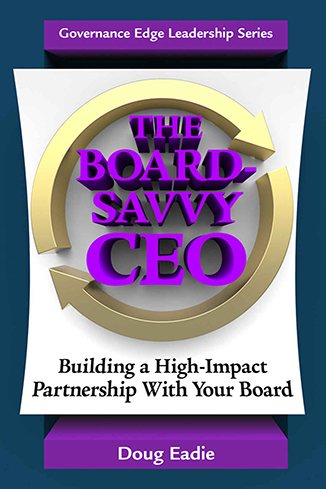I’m delighted to report that three extraordinary CEOs who have been actively engaged in this blog’s CEO Advisory Committee are scheduled to record a podcast for www.extraordinaryceo.com, sharing their experience in building a productive and enduring board chair-CEO partnership. The members of this dynamic leadership trio are Jeff Finkle, President/CEO of the International Economic Development Council; Ronnie Bryant, President & CEO of the Charlotte Regional Partnership; and Michael Langley, CEO of the Minneapolis Saint Paul Regional Economic Development Partnership. Ronnie and Mike will draw not only on their experience in working with the board chairs of their own organizations, but also on their experience as chairs of the IEDC Board and close governing partners with Jeff.
I thought it would be useful to set the stage for these three CEOs’ upcoming podcast by sharing some thoughts on the board chair-CEO partnership, drawn from my book The Board-Savvy CEO (www.theboardsavvyceo.com). Let’s begin with a true story. When the CEO of a national professional association began to talk with her board chair about the need for board capacity building, she realized she had a pretty rough row to hoe. Her chair was preoccupied with his pet leadership target – putting in place a detailed strategy for international growth, as a way to deal with slow and sure decline in both members and revenues on the domestic front. And not only was he initially unconvinced that a board development initiative made sense at that point in time, he was keenly aware that three or four important board members were likely to oppose any capacity building effort, for purely selfish reasons: fear of losing the influence they’d built up over the years. The board-savvy CEO persevered, finally convincing her chair that a more fully developed governing board would be critical to successfully implementing an international expansion effort and that his being a vocal champion for board development would be essential to overcoming resistance. So donning the change champion hat, the board chair appointed a governance task force charged to come up with recommendations to strengthen the board’s role and structure, and six months later the task force recommendations were adopted unanimously. Of course, the board-savvy CEO worked closely with her chair in coming up with the right task force composition, drafted the chair’s charge to the task force, convinced the chair to head the task force, and ensured that it was well staffed.
I could share many more true stories of successful board chair-CEO collaboration, but the reader can easily see what every truly board-savvy CEO well knows: that investing in the development of a rock-solid board chair-CEO working relationship can yield powerful organizational dividends. In fact, I would suggest that one of the preeminent priorities of a truly board-savvy CEO is to transform her board chair into a strong governing partner, a reliable ally, and when needed, an ardent change champion. The board chair makes an especially important partner for the CEO not only because of her formal authority as “CEO” of the governing board, but also the fact that board chairs are often major actors who wield tremendous influence in their communities, including in the profession or industry an association represents. I’ve seen board-savvy CEOs successfully employ five major strategies in building close and productive working relationships with their board chair:
- Reach agreement with the board chair on the fundamental division of labor with the CEO.
- Get to know the board chair really well.
- Actively help the board chair succeed in her formal governing role.
- Actively assist the board chair in having a richer, more satisfying experience beyond her formal leadership role.
- And never miss an opportunity to provide the board chair with ego satisfaction, often in little but important ways.
Having worked closely over the years with Jeff, Ronnie and Mike, I know you’re in for a real treat. You’ll find their upcoming podcast chock full of practical wisdom you can put to good use in building a solid relationship with your board chair.






